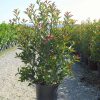“Good Bugs or Bad Bugs”
Now that most of our spring planting is done and everything is growing and looking great. Its time to make sure we keep it that way. As the temperatures begin to climb and the rainfall decreases you may begin to notice a few visitors in and around the landscape. Evidence of this can be seen in the way of yellow patches of grass or insect damage on the leaves of your favorite rose bush or hibiscus. This is evidence of a pest infestation where insects such as grub worms or other flying or crawling insects have started feasting on your plants. The best way to control these harmful pests is to organize a regular pest control program as well as maintaining a healthy lawn and landscape.
Alongside these harmful pests there are also insects that are considered to be beneficial to our landscape. Beneficial insects are insects that live in and around our landscape and feed on other harmful insects such as aphids, caterpillars, grub worms and other soft bodied insects. Today we’ll talk about the bad bugs first and finish up with the good bug solution nature intended.
“Chewing Insects”
“Bad Bugs”
Web Worms:
These grub like insects are one of the most common problems in North Texas. After several years of drought and our recent cool, wet spring, we can expect to see the familiar webs return to the canopies of your trees.
Use AB Thuricide
Caterpillars:
Caterpillars usually return to North Texas in the spring and in the fall. These are the larvae of butterflies; caterpillars include hornworms and other spring feeding worms. They feed on the leaves and flowers of your plants; witch in turn can destroy the beauty and the look of your landscape.
Use Fertilome Borer Bagworm Tent Caterpillar and leafminer Spray
Snails and Slugs:
Holes in the leaves of your begonias and other spring blooming plants are usually a sign of snails and slugs. Snails and slugs feed on the leaves, flowers, stems, and roots of plants by biting off the tissue or chewing small holes in the leaves and flowers. They are most noticeable by the slime trails you see on sidewalks, decks and porches that can last for up to a week. Snails require lots of moisture. Controlling the moisture level around your lawn grasses and around your floral beds can help discourage these insects.
Use Hi Yield Slug and Snail Bait
Grubs Worms:
These large white worms are most visible during the hot summer months. They feed on the roots of turf grass. Dead, dying or brown patches in your St. Augustine or Bermuda lawns can be a sign that Grub Worms are present.
Use Hi Yield Turf Ranger
“Sucking Insects”
“Bad Bugs”
Aphids:
These are small insects, with piercing and sucking mouthparts. These insects are a common problem in most landscapes. Aphids suck the moisture from plants, causing dried disfigured leaves and blooms. You will find aphids on annuals and perennials, crepe myrtles, roses and other various plants through out the growing season.
Use Fertilome Triple Action Plus or Frtilome Tree and Shrub systemic drench
Spider Mites:
These nearly microscopic insect use tiny microscopic straw like mouth structures to pierce the plant cells. Mites pierce clusters of surface cells and suck out the contents leaving damaged cells which appear yellow at first and then turn brown. They are very hard to detect until damage has occurred, the photo above is a good example of how the leaf will look once infected.
Use Hi Yield Bug Blaster II
“Biting Insects”
Fire Ants:
These insects usually do not damage plants, however fire ants have become one of the leading problems in most North Texas landscapes. There are several pesticides available for the treatment of fire ants. Boiling water poured into the mound is helpful. A chemical drench poured over the mound or fire ant granules applied across the mound are usually more effective. Fire ant bait is another option that is available.
Use Hi Yield Fire Ant Control Granules or Fertilome Come And Get It
“Beneficial Insects”
“Good Bugs”
“Good Bugs” are critical to any thriving landscape and should be a welcome sight in your landscape or garden! Bee’s and certain other insects play an intricate part in the pollination of many types of flowers and plants. Beneficial or predatory insects such as ladybugs and praying mantis feed on many species of harmful pests and insects. Insects such as spiders lay their eggs inside or on top of other pests, including grubs, using them for food for their larvae.
Ladybugs:
Adult ladybugs and their larvae’s favorite meal are aphids, especially the aphids that often infest roses. Lady Bugs are ferocious feeders that feed on scale insects, mealy bugs, mites, and powdery mildew as well.
Spiders:
There are at least 3,000 different species of spiders in North America that are actually helpful to your landscape. Spiders, like Lady Bugs are predatory insects that feed on aphids, beetles, mites, fire ants and other spiders.
Lacewings:
Tiny insects with delicate wings feed on aphids, mealy bugs, scale, and mites. Just one Lacewing larva can eat more than 100 insects in a single day.
Parasitic Wasp:
Black and yellow insects ranging from microscopic insects to nearly an inch long that feed on caterpillars, grubs and other insects.
Praying Mantis:
Praying Mantis have large appetites, which can help to control various insects and pests naturally feeding on insects of most any size.



